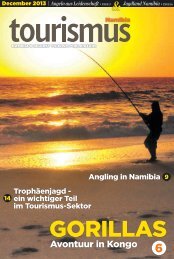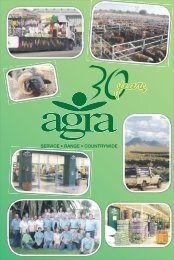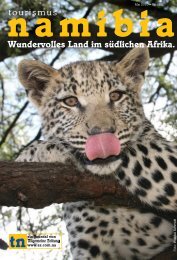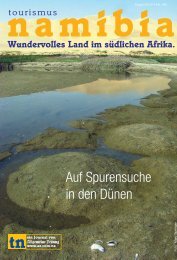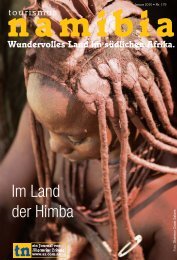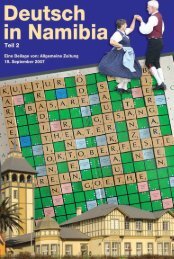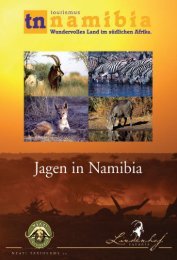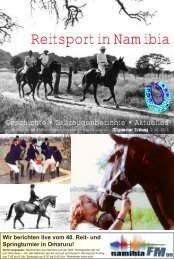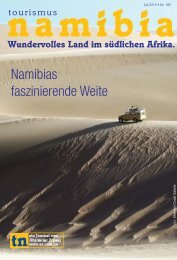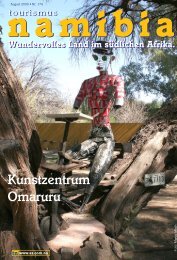Visit our stall at Presidents Hall, P3 A - Allgemeine Zeitung Namibia
Visit our stall at Presidents Hall, P3 A - Allgemeine Zeitung Namibia
Visit our stall at Presidents Hall, P3 A - Allgemeine Zeitung Namibia
Create successful ePaper yourself
Turn your PDF publications into a flip-book with our unique Google optimized e-Paper software.
Sycamore Figs very often develop a highly<br />
fluted trunk which serves to anchor them in<br />
the soil so well th<strong>at</strong> even elephants cannot<br />
uproot them.<br />
takes over from the first without interruption of<br />
the process – so remember to be gr<strong>at</strong>eful for<br />
blitz and similar products next time you wish<br />
to braai.<br />
The Sycamore bears the largest of all indigenous<br />
figs in <strong>Namibia</strong>. The first figs to ripen<br />
are said to be sweet and good to e<strong>at</strong>. L<strong>at</strong>er fruit<br />
reportedly do not taste th<strong>at</strong> well and are used<br />
to brew an alcoholic drink called “ombike”. An<br />
elderly gentleman from the north told me: “Our<br />
mothers put us through school on the money<br />
they earned brewing this drink”. Fine specimens<br />
of these fig trees as well as Marula (Sclerocarya<br />
birrea) trees and the Wild D<strong>at</strong>e (Berchemia dis-<br />
color) can often be found growing in the mahangu<br />
fields in northern <strong>Namibia</strong>, where they<br />
are the property of one particular person who<br />
is the sole owner of its fruits.<br />
Fruit-e<strong>at</strong>ing birds and b<strong>at</strong>s, elephant, giraffe,<br />
kudu, duiker, wart hogs, baboons, monkeys<br />
and many others feed on the fruit of the Sycamore<br />
Fig. The leaves stimul<strong>at</strong>e milk production<br />
in cows and are a valuable fodder in semi-arid<br />
areas. The large trees provide shelter for many<br />
insects, birds, reptiles and small mammals. A<br />
strong rope can be made from the tough inner<br />
bark. A decoction of the bark and milksap is<br />
used as a cough mixture. Skin inflamm<strong>at</strong>ions<br />
are tre<strong>at</strong>ed with the sap alone. The finely powdered<br />
bark is used to tre<strong>at</strong> burns.<br />
Names : Ficus sycomorus; G. W<strong>at</strong>erbergfeige,<br />
Sykomore, Maulbeerfeige; E. sycamore Fig; A.<br />
wildevy; H. omukuyu<br />
In addition – some intriguing facts about the<br />
fruits of fig trees. Wh<strong>at</strong> we call the fruit of a fig<br />
tree is in fact the receptacle which thickens to<br />
engulf the flowers, while the fruits are the tiny<br />
pips inside the fig. Pollin<strong>at</strong>ion is accomplished<br />
by a species of tiny wasp th<strong>at</strong> enters the fig<br />
through a small opening <strong>at</strong> the top. A different<br />
species of wasp is associ<strong>at</strong>ed with each species<br />
of fig tree. Thus the survival of these big trees<br />
actually depends upon the survival of these tiny<br />
wasps. Imagine the loss if these wasps were to<br />
be destroyed by the indiscrimin<strong>at</strong>e use of pesticides!<br />
The characteristic fe<strong>at</strong>ures of Fig trees in <strong>Namibia</strong><br />
are: simple leaves, usually with smooth<br />
margins; smooth pale grey or whitish to yellowish<br />
trunks which are often fluted; a sticky<br />
white l<strong>at</strong>ex exuded by all parts of the tree when<br />
injured and the little pointed cap covering the<br />
31 June 2009<br />
growth point of each twig. Armed with this<br />
knowledge you will now also be able to identify<br />
some additional fig species occuring in <strong>Namibia</strong><br />
but not easily visible from main roads. They<br />
are the Rock-splitting Fig (F. ilicina), usually a<br />
rock-creeping shrub found only in rocky areas.<br />
Its distribution is similar to th<strong>at</strong> the Namaqua<br />
Rock-fig. The Rock-splitting Fig has particularly<br />
tough, thick, simple leaves. While it usually covers<br />
rocks and cliff faces like a creeper it can also<br />
form small trees. The Sandpaper Fig (F. capreifolia)<br />
often forms dense thickets along the edge<br />
of the Kunene River, while the Hairy Rock–fig (F.<br />
glumosa)is confined to rocky places in northwestern<br />
<strong>Namibia</strong> and the Pygmy Fig (F. pygmea)is<br />
found as a multi-stemmed shrub in the<br />
Popa Falls area along the Okavango River. n<br />
advertorial<br />
Lapa Lange<br />
By Estekke de Bruyn<br />
Luise Hoffmann<br />
Lapa Lange is one of the new exhibitors <strong>at</strong><br />
this year’s <strong>Namibia</strong> T<strong>our</strong>ism Expo.<br />
This haven in n<strong>at</strong>ure is loc<strong>at</strong>ed 35 kilometres<br />
along the M29 road on the way to Gochas on<br />
the edge of the Kalahari.<br />
It has sleeping facilities for 21 guests in ensuite<br />
self-c<strong>at</strong>ering units as well as en-suite<br />
rooms which offer a dinner, bed and breakfast<br />
service. Camping facilities are also available<br />
on the lawn or around the w<strong>at</strong>er hole.<br />
Lapa Lange’s restaurant offers uniquely <strong>Namibia</strong>n<br />
country style cuisine and can also<br />
serve a la carte meals when required.<br />
Owners, Piet and Ems de Lange, however<br />
prefer to introduce visitors to the traditional<br />
camp fire experience serving potjiekos and<br />
lapa barbecues. This offers a special tre<strong>at</strong> to<br />
t<strong>our</strong>ists unfamiliar with this well loved <strong>Namibia</strong>n<br />
cooking experience.<br />
According to the De Langes their whole philosophy<br />
in the oper<strong>at</strong>ion of Lapa Lange is<br />
based on the principle of <strong>Namibia</strong>n “Gemütlichkeit.<br />
Lapa Lange has its own take on so the so<br />
called Big Eight: beer, braaivleis, biltong, boeretroos<br />
(coffee) big fires, black diamond (karakul),<br />
boere music and beautiful black ladies<br />
in traditional <strong>at</strong>tire.<br />
After a feast or a long relaxing walk the rock<br />
pool is the ideal place to cool off and wash<br />
away every bit of remaining stress.<br />
<strong>Visit</strong>ors to Lapa Lange can enjoy a wide range<br />
of activities th<strong>at</strong> include walks in the game<br />
camp, a game drive or merely relaxing next<br />
to the w<strong>at</strong>er hole and w<strong>at</strong>ching a variety of<br />
game come to drink.<br />
Twenty different species of game are found<br />
on the 1 500 hectare of the lodge.<br />
Sun downer trips and dune rides on the red<br />
Kalahari dunes are also offered to guests.<br />
“Lapa Lange is n<strong>at</strong>ure friendly and it is <strong>our</strong><br />
aim to bring people closer to n<strong>at</strong>ure and its<br />
wild life,” says Mrs. De Lange.<br />
For the foreseeable future Lapa Lange is planning<br />
a self-c<strong>at</strong>ering tented camp, constructing<br />
a Nama/ Damara as well as a San (Bushmen)<br />
traditional village together with a cultural centre<br />
where the cultures of all <strong>Namibia</strong>’s ethnic<br />
groups will be fe<strong>at</strong>ured.<br />
At Lapa Lange visitors to <strong>our</strong> country will be<br />
able to enjoy a real <strong>Namibia</strong>n cultural learning<br />
experience. They will also be able to buy<br />
hand made items produced by Nama and<br />
San people.<br />
Lapa Lange is the ideal stop over for t<strong>our</strong>s<br />
into the Kalahari. Light lunches for bus t<strong>our</strong><br />
groups can be offered or smaller t<strong>our</strong> groups<br />
can spend the night in the rooms or self-c<strong>at</strong>ering<br />
units.<br />
For more inform<strong>at</strong>ion feel free to contact Pieter<br />
or Ems de Lange <strong>at</strong> telephone (00264)<br />
(063) – 241801, fax: 088614881 or on either<br />
of these cell phone numbers: 0811283445 or<br />
0811291085. They can also be contacted by<br />
e-mail <strong>at</strong> charfarm@mweb.com.na. <strong>Visit</strong> their<br />
website, www.lapalange.com to learn more<br />
about this jewel of the Kalahari.



